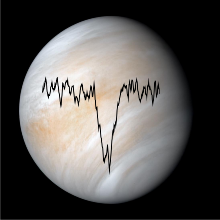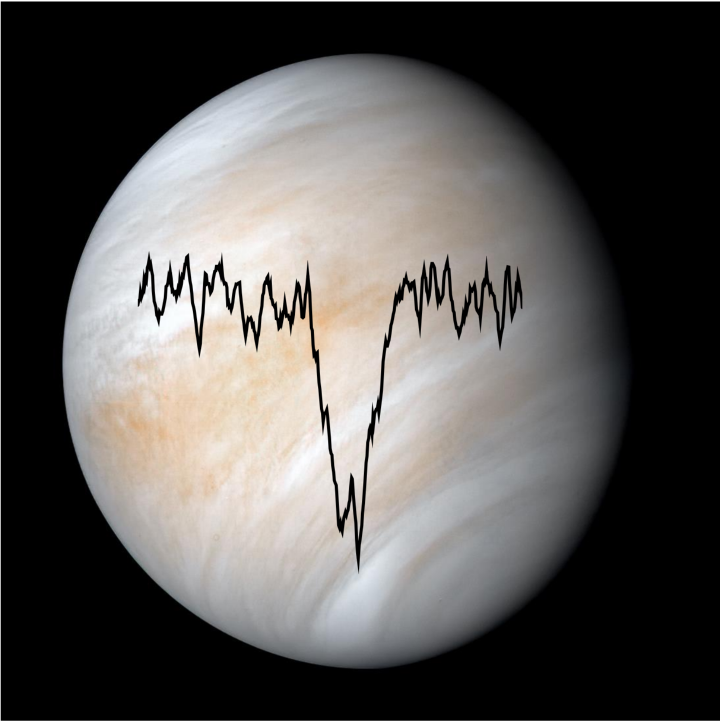The Solar System has two remarkably similar planets – Earth and Venus. They are thought to be the same age, comparable in size, and probably formed from the same materials. However, there are also major differences between these two celestial bodies. While Earth has a blue sky, oceans of liquid water brimming with life, and an oxygen-rich atmosphere, Venus is surrounded by dense cloud cover and an atmosphere comprising carbon dioxide, nitrogen and various trace gases.
A team led by Heinz-Wilhelm Hübers, Director of the DLR Institute of Optical Sensor Systems in Berlin, has now been able to directly measure the concentration of atomic oxygen on both the day and night sides of Venus' atmosphere for the first time.
The results were published in the journal nature on November 7, 2023 and are based on observations from the SOFIA airborne observatory, a joint project of the German and American space agencies DLR and NASA. The German SOFIA Institute (DSI) at the University of Stuttgart coordinates the SOFIA activities on the German side.
There are two strong currents in the atmosphere of Venus. Below approximately 70 kilometres, there are hurricane-force winds blowing against the direction of Venus’ rotation, but above 120 kilometres, strong winds flow in the direction of rotation. A layer of atomic oxygen exists between these two opposing atmospheric currents. This layer is produced by ultraviolet radiation from the Sun, which breaks down the carbon dioxide and carbon monoxide in Venus’ atmosphere into atomic oxygen and other products.
A direct measurement method detects atomic oxygen
Previous and current detection methods are indirect and are based on measurements of other molecules in combination with photochemical models. In November 2021, researchers from the DLR Institute of Optical Sensor Systems, the Max Planck Institute for Radio Astronomy and the University of Cologne succeeded in directly detecting the extremely reactive oxygen atoms in the atmosphere of Venus for the first time. The measurements were carried out using the spectrometer upGREAT (German Receiver for Astronomy at Terahertz Frequencies) onboard SOFIA. “The measurements were particularly challenging because Venus could only be observed with SOFIA for approximately 20 minutes on three days and was only slightly above the horizon. Thanks to upGREAT’s outstanding measurement sensitivity and SOFIA’s unique capabilities, it was possible to create a map of the oxygen distribution on Venus,” says Heinz-Wilhelm Hübers, first author of the publication announcing the results.
Results of the measurements
The emissions from Venus were measured in a narrow frequency range around 4.74 terahertz (THz), which corresponds to a wavelength of 63.2 micrometres. The atomic oxygen in Venus’ atmosphere absorbs this radiation. This is comparable to the Fraunhofer lines in the solar spectrum, which give an indication of the atoms in the Sun’s atmosphere. In the terahertz spectrum of Venus, an absorption line appears that is characteristic of atomic oxygen. The strength and shape of the absorption signal is a measure of the amount of atomic oxygen and its temperature. “We were able to show that oxygen is formed on the day side of Venus and that its concentration also drops with decreasing solar radiation. On the night side, a local increase in concentration indicates an enrichment of atomic oxygen as a result of wind currents,” Hübers explains.
The temperature of the atomic oxygen, which ranges from approximately minus 120 degrees Celsius on the day side to minus 160 degrees Celsius on the night side, indicates that it is mainly present in an altitude layer at around 100 kilometres. Its concentration is about 10 times lower than in Earth’s atmosphere. "Measuring these clear differences to Earth can contribute to a better understanding of why Earth and its sister planet Venus have developed so differently," explains Bernhard Schulz, SOFIA Science Mission Deputy Director at the University of Stuttgart.
Original publication:
- Direct detection of atomic oxygen on the dayside and nightside of Venus¸ nature, November 7th, 2023, Volume 14, page 1-7; DOI number: 10.1038/s41467-023-42389-x
- POC:
Heinz-Wilhelm Hübers: (Heinz-Wilhelm.Huebers@dlr.de)
Links to the latest news:
- Atomarer Sauerstoff auf der Tag- und Nachtseite der Venusatmosphäre, Pressemitteilung des DLR-Instituts für Optische Sensorsysteme, November zth, 2023
- First direct detection of atomic oxygen in Venus' atmosphere, notice from MPIfR, November 7th, 2023
Further SOFIA Links:
- SOFIA Science Center
- NASA SOFIA Missions Page
- NASA SOFIA blog
- SOFIA Mission Page of DLR Space Agency (German)
- DLR Blogs for SOFIA (partly in German)
- DSI Image Galery (German)
- News Overview (partly in German)
- Project Chronicle (German)
SOFIA, the "Stratospheric Observatory for Infrared Astronomy" is a joint project of the Deutsches Zentrum für Luft- und Raumfahrt e.V. (DLR; German Aerospace Center, grant: 50OK0901, 50OK1301, 50OK1701, and 50OK2002) and the National Aeronautics and Space Administration (NASA). It is funded on behalf of DLR by the Federal Ministry for Economic Affairs and Climate Action based on legislation by the German Parliament, the State of Baden-Württemberg and the University of Stuttgart. SOFIA activities are coordinated on the German side by the German Space Agency at DLR and carried out by the German SOFIA Institute (DSI) at the University of Stuttgart, and on the U.S. side by NASA and the Universities Space Research Association (USRA). The development of the German instruments was funded by the Max Planck Society (MPG), the German Research Foundation (DFG) and DLR.
upGREAT is a further development of the German Receiver for Astronomy at Terahertz Frequencies (GREAT), a far-infrared spectrometer that has been used to carry out numerous successful scientific flights on board SOFIA since 2011. The instrument was developed and built by a consortium of German research institutes – the Max Planck Institute for Radio Astronomy and the Cologne Observatory for SubMillimeter Astronomy (KOSMA) at the University of Cologne, in collaboration with the DLR Institute of Optical Sensor Systems in Berlin.




